Article
Avoiding a Brain Health Innovation Market Failure: Lessons from the Hype Cycle
Author(s):
New approaches to ensure that the brain health technology sector continues to flourish for decades.
brain-electric_ Siarhei/Adobe Stock

As brain health investing sees unprecedented growth and activity, how do we ensure a sustainable rate of progress going forward? An editorial in JAMA Psychiatry reported that “In 2019 alone, venture capital (VC) companies invested a record-breaking $637 million in more than 60 different mental health-oriented companies.”1 This has accelerated further in 2020 and 2021.2 The whole VC field is booming, and beyond just mental health care, investment in the broader field of brain health science and technology is also on the rise.3,4
There is a good reason for this: Brain health technologies are essential clinical tools for addressing the global brain health pandemic and its multiple social and technological changes.5 These technologies—spanning omics, digital therapeutics, artificial intelligence, and devices—aim to improve access, screening, prevention, diagnosis, and treatment. There is an increasing convergence of these types of solutions as clinicians, health systems, and payors attempt to simplify clinical workflows and minimize fragmentation of new products and services (Figure 1).6
Figure 1. Overview of Brain Health Technologies

With investment in brain health growing so quickly, it is easy to be optimistic about the current and future state of the field. Recent societal trends reinforce the ostensibly rosy picture. The COVID-19 pandemic accelerated the destigmatization of mental illnesses and highlighted the importance of brain health to the public.7 Similarly, the pandemic has unveiled as never before intrinsic connections between mental and brain health, economy, innovation, and wellbeing.8,9 It is crucial, though, that we do not take progress for granted and rest on our laurels. It is also critical that we take a responsible approach to this field, which is very vulnerable to hope (due to the dire suffering and intense want for relief) and hype (due to major business opportunities).10
Indeed, the stakes are too high. Given the multi-trillion-dollar costs of mental health disorders, the poor standard of routine care, and the projected rises in prevalence and economic burden of mental health disorders in the coming decades, sustained investment into brain health is critical.6,11-13 The show must go on! In order to protect and reinforce the vibrant brain health ecosystem, we must anticipate risks of market failure and work to proactively mitigate them. We wrote about this recently; however, this article is a much more extensive thesis and set of recommendations.
Booms and Busts
The Hype Cycle (Figure 2) is a graphical depiction of a common pattern that arises with each new technology or other innovation.14 It represents the maturity, adoption, and social application of specific technologies (Table 1). We believe the Hype Cycle is relevant to the frontier brain health technology field and can provide a cautionary tale for the field.
Figure 2. The Hype Cycle14
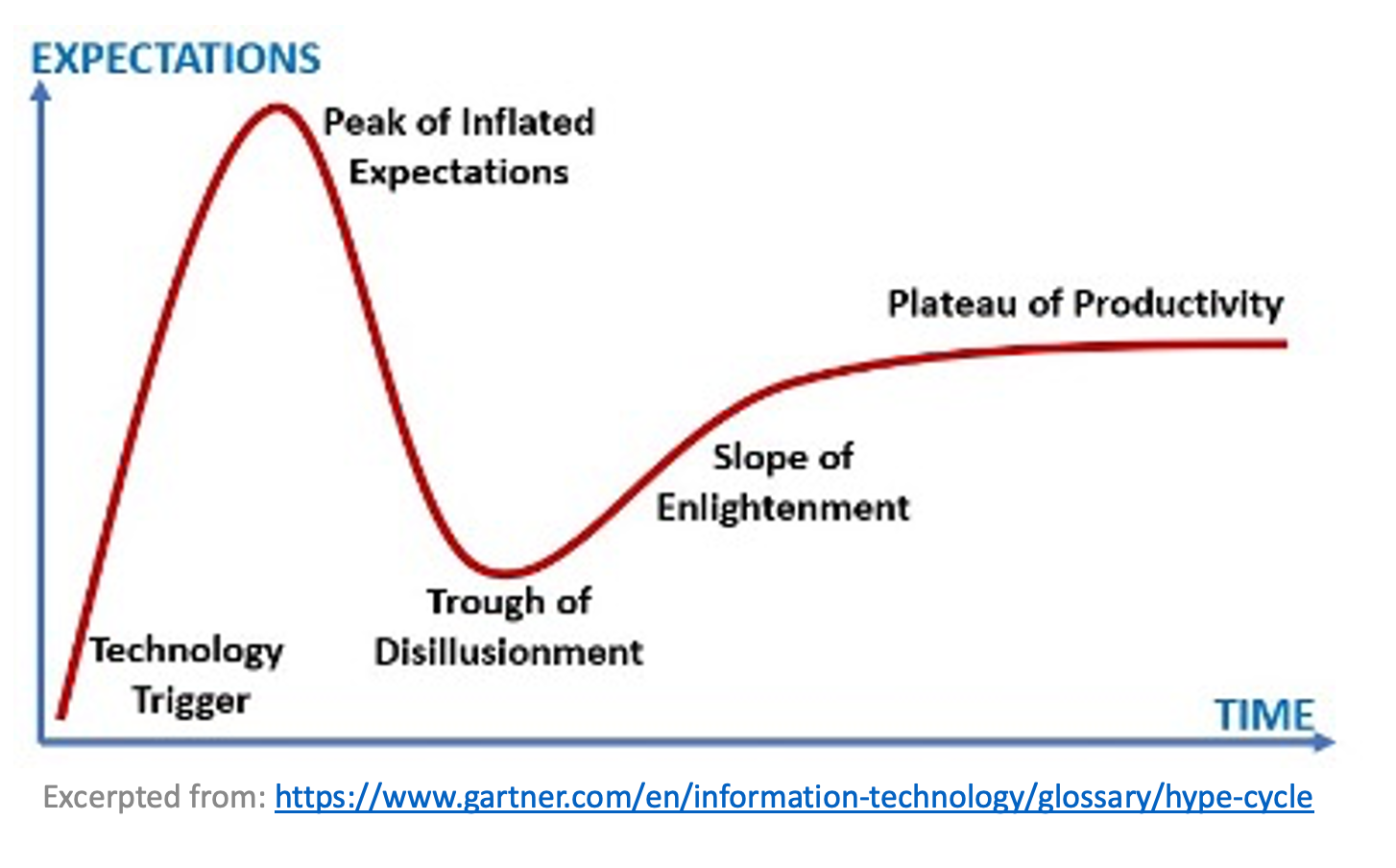
Table 1. The Hype Cycle15
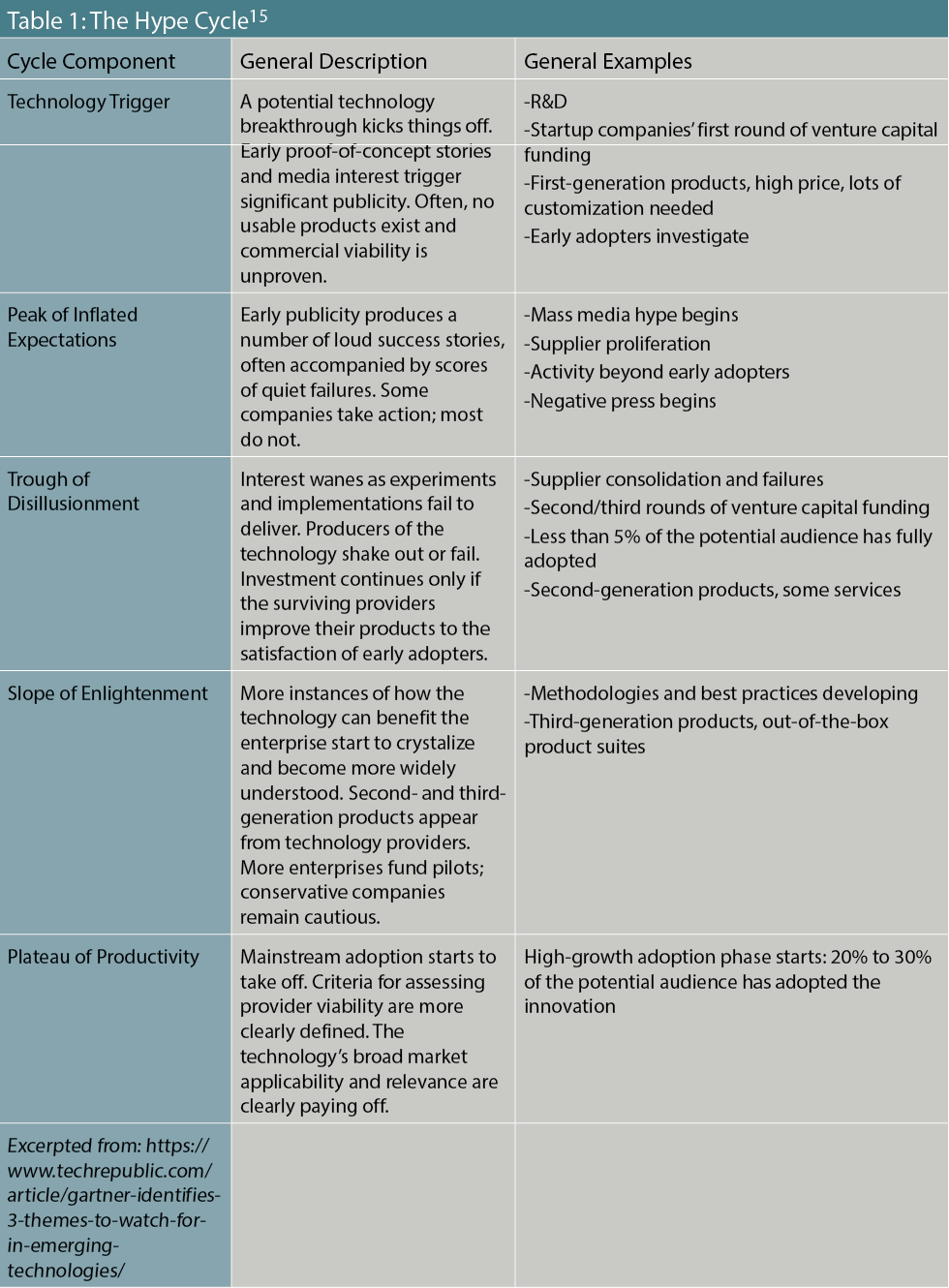
Risks for the Frontier Brain Health Technology Field
We are seeing signs of “Peak of Inflated Expectations” in this field. There are regular news articles touting the rising rates of VC investment, which have helped create a record number of brain health “unicorn” companies (companies valued over $1 billion).16 Concerns have been raised over the emergence of public disclosure of speculative valuations and seemingly inflated valuations (for instance, the digital therapeutics company Pear Therapeutics achieved a valuation of $1.6 billion with less than $4 million in revenue).17,18 Many commercially successful technologies have major consumer demand, but are not yet integrated into clinical workflows. There is also a common disconnect between commercially successful apps vs those that are validated and more likely to be accepted in clinical practice guidelines. Some have deemed the digital mental health technology field the “lawless wild west,” citing concerns around false claims and poor data privacy management practices.19 Digital phenotyping has failed to make it into clinical workflows.20
Further, there are significant safety concerns from post-marketing safety data of a popular new antidepressant, esketamine.21 Such post-marketing data is often not taken into account in the initial go-to-market excitement. Of course, this data is in and of itself a cautionary tale for the psychedelics field, which has received huge investor interest and public interest.22,23 Psychedelics in psychiatry to date have no post-marketing data, and no study to date is powered to detect conversion to psychosis. Nonhallucinogenic forms of these molecules may be helpful.24 Taken together, these issues create significant concern for this field’s sustainability.
There is thus a risk that the field will slip into the “Trough of Disillusionment.” This will be disappointing, given that every company failure may represent potentially valuable products and services that will not help patients. Moreover, novel intellectual property will be lost. Much of this downward slide will be driven by conventional VC models that are suboptimal for the brain health technology field. Conventional or general VC models rely on financial executives with minimal to no domain experience. The 2/20 model values financial returns within a set timeframe and disincentivizes significant operational input from general partners (GPs).24 Additionally, strategies prevalent in technology startups may not always transfer well to health care startups (eg, “fake it ‘til you make it,” “move fast and break things,” and Theranos). Problems we observe with conventional VC models are outlined in Table 2.
Table 2. How Conventional Venture Capital May Risk Sliding the Field Into the “Trough of Disillusionment”
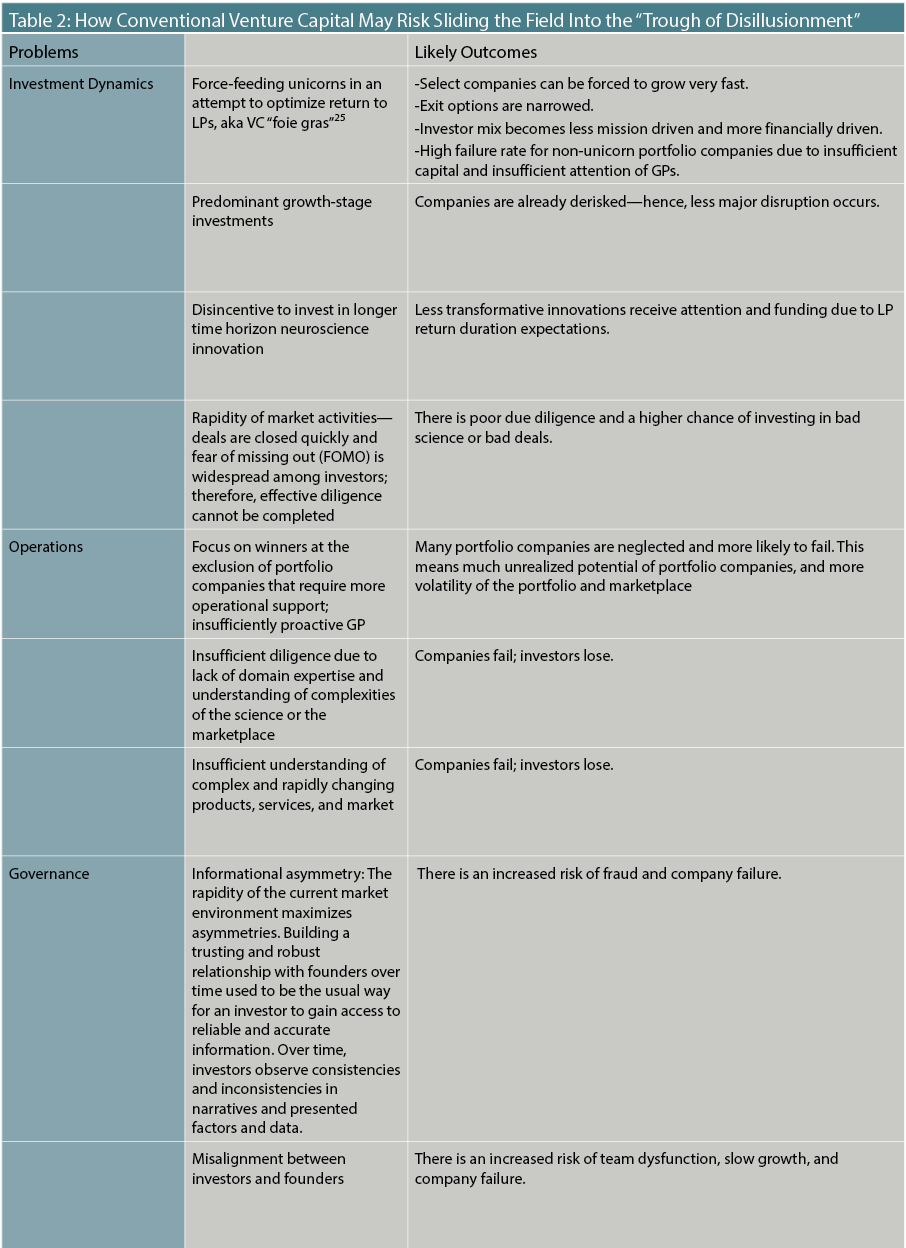
A Brain Health Technology Market Sustainability Grand Strategy
We suggest a grand strategy that could enable the field to bypass the “Trough of Disillusionment” and progress directly to the “Plateau of Productivity.” VC remains a critical component, but we believe it is imperative to consider additional investment, operational, and governance approaches. We outline these approaches to optimize the field’s sustainability in Table 3.
Table 3. Elements of a Brain Health Technology Market Sustainability Grand Strategy
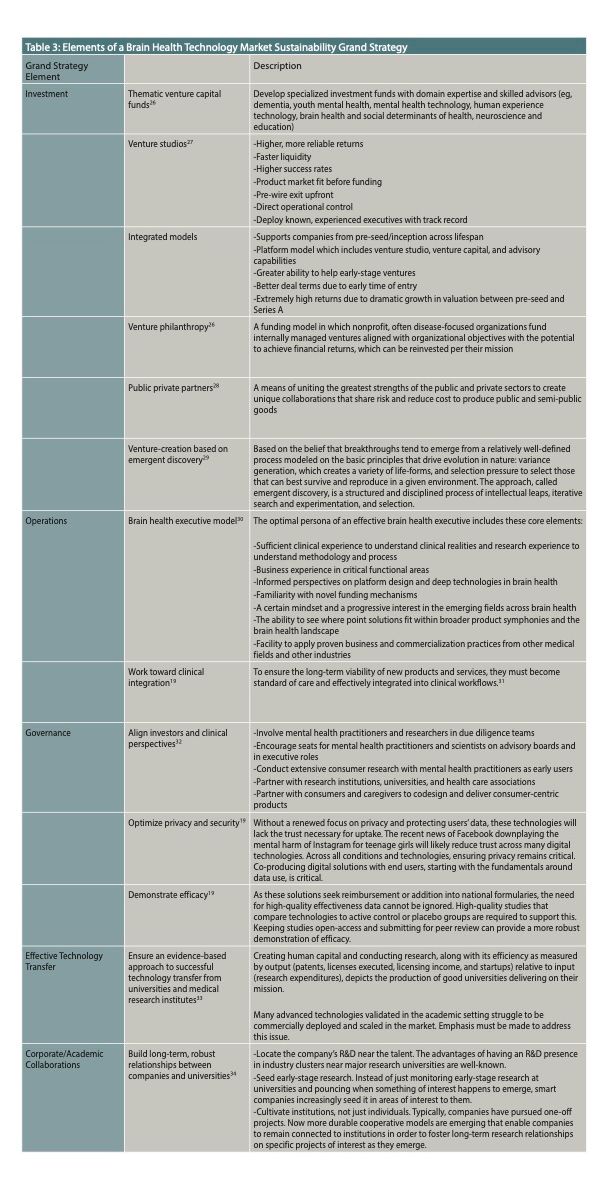
To optimize the integrity and legitimacy of brain health technology investing, it is key to develop standards and best practices with major international stakeholders. Examples may include the World Health Organization, the United Nations, and the Organisation for Economic Co-Operation and Development (OECD). Engagement with these groups will support sustained engagement with sovereign wealth funds, pension funds, mutual funds, and other large multinational corporations. Moreover, to ensure a global impact, global stakeholders must face the challenges to assure brain health development in low- and middle-income countries (LMICs), where multiple structural conditions may block progress and sustainability. For example, the October 2021 WHO Mental Health Atlas outlined a global lack of progress in leadership, governance, and financing.35 They noted:
“None of the targets for effective leadership and governance for mental health, provision of mental health services in community-based settings, mental health promotion and prevention, and strengthening of information systems were close to being achieved.”35
The new UN Health Innovation Exchange is a step in the right direction aiming to connect funders, investors, and innovations. Other progress has recently been made. We noted that the Sustainability Accounting Standards board included mental health and wellbeing in its proposed updated human capital standards.36,37 Also, a new ISO standard 45003 gives guidance on managing psychological health and safety risks within an occupational health and safety management system38; the Business Roundtable noted that the generation of a healthy environment is a key purpose of a corporation39; and the signatories of the Principles of Responsible Investing listed mental health as one of the top 4 social issue priorities in the future.40
Further, the OECD’s New Approaches to Economic Challenges unit has established a Neuroscience-inspired Policy Initiative that seeks to reconceptualize and revitalize the economy and how it works in new ways, laying the groundwork to identify relevant metrics while building a transdisciplinary network of stakeholders. The initiative will rapidly refine and advance the concept of Brain Capital (a novel asset class grossing up brain health and brain skills) via a series of research projects, surveys, data collection, economic modeling, seminars, and clear policy analyses and recommendations.9
Tracking Brain Health Technology Market Sustainability
Tracking metrics on this topic would be useful, given the risks outlined in this article. Metrics of company and market sustainability could offer investors greater ability to make scientifically and data-grounded investments and to ensure the field develops sustainably. However, developing representative metrics of company and market sustainability is challenging in a market where most investments flow into private companies. This precludes the use of typical financial metrics such as free cash flow and yearly revenue. While private companies will disclose data, it is likely that they will only release information that is self-serving and can generate interest from investors and the general public. Further, given the strength of the financial incentives of both limited partners and fund managers, it will be challenging to achieve a more sustainable approach. Financial incentives prioritize force feeding unicorns to maximize exit price and maximizing the share price of public companies. Most likely, metrics will need to be carefully developed by integrating data and judgment in a transparent way, possibly through the tools of multi-criteria decision analysis.41
Tracking market sustainability is further challenged by the information asymmetry inherent in a field largely reliant on highly technical advances.42 This enables companies to craft a reductionist and self-serving story of how their products function, a phenomenon exemplified by Theranos. Moreover, many life science companies themselves do not fully understand how their products work, which complicates efforts to overcome the information asymmetry rife in the brain health technology field.43
Nonetheless, we believe there are available metrics that could help form an index of company and broader brain health market sustainability. These measures represent outputs that can help investors mitigate the risk of company and broader market failures. Table 4 outlines such elements that may be included in a proposed brain health market sustainability index.
Table 4. Potential Components of a Brain Health Market Sustainability Index
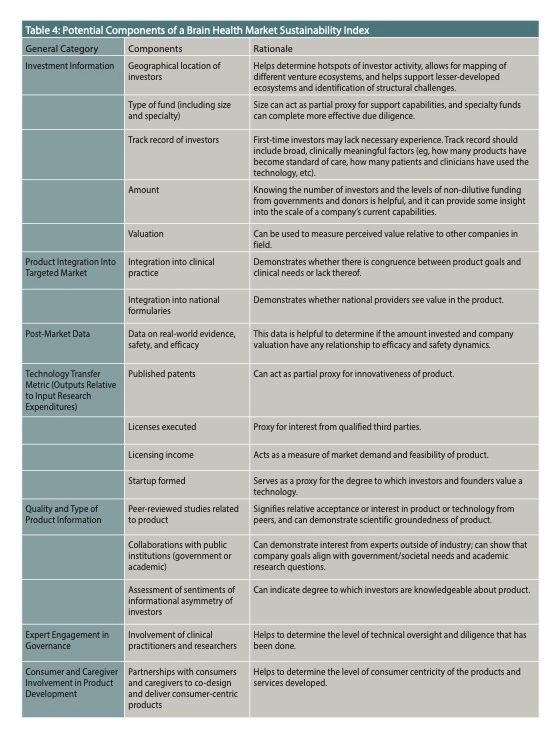
The Medical Futurist recently published a project mapping 50 emerging digital health technologies onto the Hype Cycle.44 We suggest that this type of project should be completed specifically in the brain health technology field, and it should involve surveys of diverse stakeholders from many countries. Then tracking where individuals believe brain health technology map onto the Hype Cycle in a yearly manner would be prudent to guide the field.
Conclusion
In the brain health technology field, there is considerable variability concerning where particular technologies and technology classes sit in the Hype Cycle. Therefore, further work is required to map specific examples onto the cycle. However, irrespective of where these examples stand, formalizing and employing the abovementioned sustainability strategy in the United States, where most investment is currently directed, could mitigate the risk of a broader brain health market failure.2 Of course, we believe our approach should also be deployed proactively outside the United States, especially as global investment begins to increase. We hope that it may even be possible to largely avoid the “Trough of Disillusionment” and reach the “Plateau of Productivity.” We believe our approach could sustain the brain health technology market for decades. Humanity deserves and needs it!
Mr Asher is an undergraduate studying neuroscience at Dartmouth College. Ms Smith is a director at the PRODEO Institute, an Atlantic Fellow in Brain Health Equity at the Global Brain Health Institute at the University of California, San Francisco, and a Thiel Fellow at Stanford University. Mr Heinemeyer is cofounder of the PRODEO Institute and CEO of PRODEO. Dr Berk is Alfred Deakin Professor of Psychiatry at Deakin University and director of IMPACT at Deakin University (Institute for Mental and Physical Health and Clinical Translation). Dr Ibanez is the director of the Latin American Brain Health Institute, a senior researcher at the Universidad de San Andrés, and a Senior Atlantic Fellow at the GBHI at the UCSF and Trinity College Dublin. Dr Chen is a venture capitalist and an adjunct faculty member at UC Berkeley and Singularity University. Dr Fu is a venture capitalist and an adjunct professor in engineering at Stanford University. Dr Wolfe is a senior clinical advisor for Cohen Veterans Bioscience’s Trauma Research Programs who also serves as strategic advisor co-leading CVB’s Suicide Strategy Initiative. Dr Abbott is a corporate attorney, a professor of law at University of Surrey, and an adjunct professor with the UCLA David Geffen School of Medicine. Mr Veron is venture capitalist, founder and managing partner at Newfund Capital. Mr Ellsworth is an undergraduate studying computer science at Stanford University. Dr Leboyer is the CEO of Fondation FondaMental and professor of psychiatry at University Paris Est Créteil. Dr Ling is a neurologist, neuroscientist, and technologist. He is an adjunct professor with the Department of Neurology at Johns Hopkins School of Medicine and co-lead of The BrainHealth Project at the Center for BrainHealth at The University of Texas at Dallas. Dr Linkov is senior scientific and technical manager at the US Army Engineer Research and Development Center, where he manages crisis response and resilience project portfolio. Dr Haas is the CEO and president of Cohen Veterans Bioscience. Dr Eyre is cofounder of the PRODEO Institute and co-lead of the OECD NIPI, and he holds adjunct roles with IMPACT at Deakin University, GBHI at UCSF, Brain Health Nexus at Cohen Veterans Bioscience, and Baylor College of Medicine. He is a probono strategic advisor to the HEKA Fund (a collaboration of Newfund Capital and FondaMental Fondation).
References
1. Shah RN, Berry OO. The Rise of Venture Capital Investing in Mental Health. JAMA Psychiatry. 2021;78(4):351-352.
2. Primack D. The mental health deal boom. Axios. July 29, 2021. Accessed October 12, 2021.
3. Zhang H. VC valuations climb even higher. Institutional Investor. August 23, 2021. Accessed October 12, 2021.
4. Scientifica. NeuroWire: The best neuroscience news stories from January 2021. Scientifica.uk.com. 2021. Accessed October 12, 2021.
5. Eyre H, Carson J, Smith E, et al. Boosting brain health after COVID-19: a convergence solution. Psychiatric Times. May 14, 2021. Accessed October 12, 2021.
6. Eyre H, Berk M, Lavretsky H, et al. Convergence Mental Health. Oxford University Press; 2021.
7. Gold J. Could COVID-19 finally destigmatize mental illness? Time. May 13, 2020. Accessed October 12, 2021.
8. Eyre HA, Ayadi R, Ellsworth W, et al. Building brain capital. Neuron. 2021;109(9):1430-1432.
9. Smith E, Ali D, Wilkerson B, et al. A brain capital grand strategy: toward economic reimagination. Mol Psychiatry. 2021;26(1):3-22.
10. Eyre HA, Ellsworth W, Fu E, et al. Responsible innovation in technology for mental health care. Lancet Psychiatry. 2021;7(9):728-730.
11. United Nations. Mental health matters. UN.org. 2021. Accessed October 12, 2021.
12. The Lancet Global. Lancet Commission: inaction on mental health crisis will cost world $16 trillion by 2030. Lancet Glob Health. 2020(11):e1352.
13. Smith E, Ojha R, Lo AW, et al. A brainier approach to ESG investing. Psychiatric Times. March 25, 2021. Accessed October 12, 2021.
14. Gartner. Hype Cycle. Gartner.com. 2021. Accessed October 12, 2021.
15. Shein E. Gartner: 3 themes to watch in emerging technologies. IBM. August 24, 2021. Accessed October 12, 2021.
16. Aguilar M. Soaring mental health unicorns race to meet employer needs. STAT. February 16, 2021. Accessed October 12, 2021.
17. Primack D. How private markets embraced valuation disclosure. Axios. April 30, 2021. Accessed October 12, 2021.
18. Reuter E. Pear Therapeutics plans to go public in $1.6B SPAC deal. MedCityNews. June 22, 2021. Accessed October 12, 2021.
19. Torous J, Bucci S, Bell IH, et al. The growing field of digital psychiatry: current evidence and the future of apps, social media, chatbots, and virtual reality. World Psychiatry. 2021;20(3):318-335.
20. Reuter E. Smartphones could be used to detect depression, Verily finds. MedCityNews. October 3, 2021. Accessed October 12, 2021.
21. Gastaldon C, Raschi E, Kane JM, et al. Post-marketing safety concerns with esketamine: a disproportionality analysis of spontaneous reports submitted to the FDA Adverse Event Reporting System. Psychother Psychosom. 2021;90(1):41-48.
22. Vargas MV, Meyer R, Avanes AA, et al. Psychedelics and other psychoplastogens for treating mental illness. Frontiers in Psychiatry. October 4, 2021. Accessed October 12, 2021.
23. Weintraub A. Investors are tripping on psychedelics startups despite a murky path to commercial success. Questex. August 16, 2021. Accessed October 12, 2021.
24. Picard E. Two and twenty. Investopedia. March 3, 2021. Accessed October 12, 2021.
25. Warner C, Wilson T. The danger of venture capital ‘foie gras.’ Sifted. March 29, 2021. Accessed October 12, 2021.
26. Smith RA, Kaspar BK, Svendsen CN. Neurotherapeutics in the Era of Translational Medicine. 2020. Elsevier Inc.
27. High Alpha. Pioneering the venture studio business model. High Alpha. 2021. Accessed October 8, 2021.
28. Fisher NF. What factors influence success in public-private partnerships? Lessons for neuroscience policy. ProQuest Dissertations Publishing. 2020.
29. Afeyan N, Pisano GP. What evolution can teach us about innovation. Harvard Business Review. 2021. Accessed October 8, 2021.
30. ICN Online Editor. Brain health executives: a transdisciplinary workforce innovation—a commentary. Innovations in Clinical Neuroscience. June 1, 2021. Accessed October 8, 2021.
31. Mohr DC, Azocar F, Bertagnolli A, et al. Banbury Forum consensus statement on the path forward for digital mental health treatment. Psychiatric Services. 2021;72(6):677-683.
32. Carson J, Noori S, Dunn A, et al. Buyer beware: why investors and mental health practitioners must sit on the same side of the table. Psychiatric Times. May 18, 2021. Accessed October 8, 2021.
33. DeVol R, Ratnatunga M. Concept to Commercialization: The Best Universities for Technology Transfer. Milken Institute. April 2017.
34. Lutchen KR. Why companies and universities should forge long-term collaborations. Harvard Business Review. January 24, 2018. Accessed October 8, 2021.
35. World Health Organization. WHO report highlights global shortfall in investment in mental health. News release. World Health Organization. October 8, 2021. Accessed October 12, 2021.
36. Smith E, Hynes W, Eyre H. Modern capitalism must prioritize our minds and brains. Psychiatric Times. July 22, 2021. Accessed October 12, 2021.
37. Sustainability Accounting Standards Board. Human capital: preliminary framework: executive summary. Sustainability Accounting Standards Board. December 2020. Accessed September 18, 2021.
38. Naden C. Mental health in the workplace: the world’s first International Standard just published. ISO. June 8, 2021. Accessed September 18, 2021.
39. Business Roundtable. Statement on the Purpose of a Corporation. Business Roundtable. February 2021. Accessed September 18, 2021.
40. Reynolds F. COVID-19 accelerates ESG trends, global investors confirm. Principles for Responsible Investment. September 3, 2020. Accessed September 18, 2021.
41. Linkov I, Moberg E, Trump BD, et al. Multi-Criteria Decision Analysis: Case Studies in Engineering and the Environment. CRC Press; 2020.
42. Smith E, Heinemeyer M, Wolfe J, et al. Sustaining investment in brain health: the dangers of information asymmetry. Psychiatric Times. October 12, 2021. Accessed October 12, 2021.
43. Bousman CA, Eyre HA. “Black box” pharmacogenetic decision-support tools in psychiatry. Braz J Psychiatry. 290209;42(2):113-115.
44. The Medical Futurist. Hype cycle of the top 50 emerging digital health trends by The Medical Futurist. The Medical Futurist. October 5, 2021. Accessed October 12, 2021.






